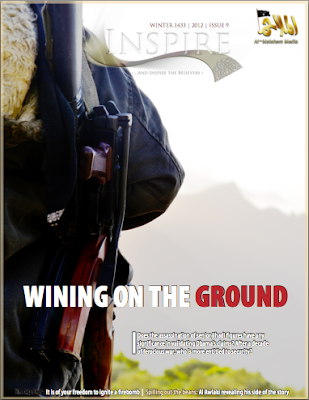Seven months after Samir Khan, the creator of
Inspire Magazine, was killed in a drone strike along with Anwar al-Awlaki, the oh-so-famous English-language jihadi magazine has been resurrected. Issues 8 and 9 were released today, the first dated Fall 2011 and the second dated Winter 2012. The Fall 2011 issue was clearly written, compiled and edited by Khan before his death. It has all the usual Khan trademarks, which is made even more obvious when looking at the Winter 2012 issue, which is nothing even close to a Khan original. Though little credit was given to Khan for his mediocre at best graphic design and editing skills, issue 9 of
Inspire is full of spelling and grammar mistakes - the worst one right on the cover of the magazine... can you spot it??
An additional note about timing: Though dated Winter 2012, the ninth issue of Inspire was released on May 2, 2012 - exactly one year after the death of Osama bin Laden. This may very well be a coincidence, and not much attention is paid to bin Laden in the issue, but it seems to be a convenient date to release. As for why they waited until now to release the Fall 2011 issue, my best guess is that AQAP wanted to release two issues together - as a way of showing that Inspire Magazine did not die along with Khan, as many analysts and media outlets suspected.
A few other things to note about the issues:

The focus, as always, is still on individual jihad, but the ninth issue takes it a step further than ever before. In a feature called "The Convoy of Martyrs," AQAP encourages individuals to act alone in gathering information, preparing and ultimately executing an attack. BUT - there must be an operational leadership, which AQAP will provide as long as you email their military committee. Essentially AQAP outsources all of the dirty work, while still having overall control and knowledge of operations. The military committee helps individuals who qualify (you must be a mature Muslim that listens and obeys) select a target and train, and after an attack is carried out the committee is in charge of media coverage of the attack.
Also interesting is the article that explains step-by-step how to build a remote control detonator for a bomb. Skill Level: Novice. Of course, the author of the article explains later: "Follow the instructions carefully in the explosives field. The first mistake can be the last."

In line with focusing on individual jihad is the presence of Abu Musab al-Suri's articles in both issues (this is not unusual for
Inspire). What many may find shocking though – unless you are an expert on all things al-Suri like my colleague
Jarret Brachman – is that al-Suri provides a prioritized target list with Western interests in Arab countries first, and America itself last. This largely contradicts AQAP's target list according to priority laid out in issue 9 (see right).
Finally, both issues released today, along with all other issues of Inspire, are interested in recruitment, reader participation and wide distribution. Issue 8 mentions they are looking for volunteers to preserve Internet links of the magazine, translators, researchers, and women who can write about women-related issues for the magazine. Issue 9 encourages readers to upload the magazine on both jihadi and non-jihadi forums. Furthermore, a footnote explains that one of the articles was included because a reader contributed it, encouraging others to provide articles and see their contributions in print.







